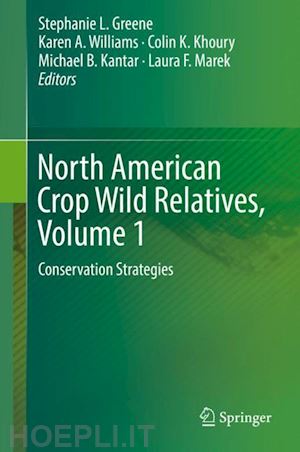
Questo prodotto usufruisce delle SPEDIZIONI GRATIS
selezionando l'opzione Corriere Veloce in fase di ordine.
Pagabile anche con Carta della cultura giovani e del merito, 18App Bonus Cultura e Carta del Docente
The plant species that humans rely upon have an extended family of wild counterparts that are an important source of genetic diversity used to breed productive crops. These wild and weedy cousins are valuable as a resource for adapting our food, forage, industrial and other crops to climate change. Many wild plant species are also directly used, especially for revegetation, and as medicinal and ornamental plants. North America is rich in these wild plant genetic resources. This book is a valuable reference that describes the important crop wild relatives and wild utilized species found in Canada, the United States and Mexico. The book highlights efforts taken by these countries to conserve and use wild resources and provides essential information on best practices for collecting and conserving them. Numerous maps using up-to-date information and methods illustrate the distribution of important species, and supplement detailed description on the potential value these resources have to agriculture, as well as their conservation statuses and needs. There is broad recognition of the urgent need to conserve plant diversity; however, a small fraction of wild species is distinguished by their potential to support agricultural production. Many of these species are common, even weedy, and are easily overshadowed by rare or endangered plants. Nevertheless, because of their genetic proximity to agriculturally important crops or direct use, they deserve to be recognized, celebrated, conserved, and made available to support food and agricultural security. This comprehensive two-volume reference will be valuable for students and scientists interested in economic botany, and for practitioners at all levels tasked with conserving plant biodiversity.
The chapters 'Public Education and Outreach Opportunities for Crop Wild Relatives in North America' and 'Genetic Resources of Crop Wild Relatives – A Canadian Perspective' are open access under a CC BY 4.0 license via link.springer.com.
Karen A. Williams is a Botanist with the USDA Agricultural Research Service National Germplasm Resources Laboratory in Beltsville, Maryland. She has an MS in Soil Science from the University of Florida, Gainesville, Florida. She manages the Plant Exploration Program for the US National Plant Germplasm System and has overseen the adaptation of the Program to the changing international regime on access and benefit sharing over the past 20 years. She has been involved in the collection, conservation and documentation of crop wild relatives in several countries. One of her current interests is the development of partnerships among different institutions to link in situ and ex situ conservation of crop wild relatives in the United States.
Colin K. Khoury is a Research Associate at the USDA Agricultural Research Service National Laboratory for Genetic Resources Preservation in Fort Collins, Colorado, and a Crop Diversity Specialist at the International Center for Tropical Agriculture (CIAT), Colombia. He holds a PhD in Production Ecology and Resource Conservation from Wageningen University, Netherlands. Colin's research interest is in enhancing food security, human health, and the sustainability of agricultural production systems through the conservation and use of crop genetic resources. He is particularly interested in the wild relatives of crops native to the United States.
Michael B. Kantar is an Assistant Professor of Plant Breeding and Genetics at the University of Hawaii at Manoa. His lab is interested in the intersection between genomics, agriculture and ecology with the goal of examining complex interactions so that everyone can work toward creating food systems that are more productive, healthy and sustainable. Currently the lab is broadly focused on the breeding and genetics of vegetable crops through the use of crop wild relatives as well as understanding the genetic basis of local adaptation. He holds a PhD in Plant Breeding from the University of Minnesota, St. Paul, Minnesota.
Laura F. Marek is the Curator for Oilseed Crops at the North Central Regional Plant Introduction Station, a gene bank in the National Plant Germplasm System supported by the USDA Agricultural Research Service, Iowa State University and the Hatch Multistate Project NC-007. Crop responsibilities include sunflower, which is native to North America and domesticated in the eastern United States. Developing collections to represent the genetic and geographic diversity of the crop and its wild relatives has been one focus of Dr. Marek’s efforts at the NCRPIS with an interest in methods that adequately assess diversity. Dr. Marek holds a PhD in Botany from Iowa State University, Ames, Iowa.










Il sito utilizza cookie ed altri strumenti di tracciamento che raccolgono informazioni dal dispositivo dell’utente. Oltre ai cookie tecnici ed analitici aggregati, strettamente necessari per il funzionamento di questo sito web, previo consenso dell’utente possono essere installati cookie di profilazione e marketing e cookie dei social media. Cliccando su “Accetto tutti i cookie” saranno attivate tutte le categorie di cookie. Per accettare solo deterninate categorie di cookie, cliccare invece su “Impostazioni cookie”. Chiudendo il banner o continuando a navigare saranno installati solo cookie tecnici. Per maggiori dettagli, consultare la Cookie Policy.